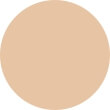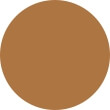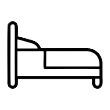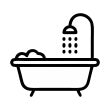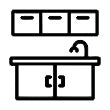Wallpaper can add a touch of elegance and beauty to any room, but some areas can pose a challenge. For instance, using traditional unpasted or pre-pasted wallpaper as a backsplash in the kitchen can be risky because it is exposed to grease and requires frequent cleaning.Similarly, hanging traditional wallpaper in a bathroom with inadequate ventilation or where water frequently splashes on the walls can be problematic.
Our pre-pasted and unpasted wallpapers are breathable and made up of paper pulp material, which can absorb water and weaken the adhesive, resulting in lifting off the wallpaper. To prevent this from happening, we recommend that if you're installing these types of wallpapers in areas prone to moisture, you take the necessary steps to waterproof them.
Due to its water-resistant properties, Peel and stick wallpaper is an excellent choice for high-moisture areas such as kitchen and bathroom walls.
To overcome these challenges, this blog will focus on waterproofing traditional unpasted and pre-pasted wallpaper, making it suitable for use in areas prone to moisture and splashes. By following the steps outlined in this blog, you'll be able to enjoy the beauty of wallpaper in your kitchen, bathroom, or any other area that was previously off-limits. So, let's get started!
Is Peel And Stick Wallpaper The Right Option For Your Kitchen And Bathroom?
Peel and stick wallpaper is a popular option for people looking to renovate their kitchen or bathroom on a budget. In addition to being affordable, they are simple to install and easy to maintain. But are they the right option for your backsplash spaces?
Yes! Peel and stick wallpapers are water-resistant because they are made from vinyl or PVC, which are naturally water-resistant materials. These materials are non-porous, which means they don't absorb water. They are also mold and mildew-resistant, making them an ideal choice for high-moisture areas. Additionally, peel and stick wallpapers are easy to clean and maintain. To clean them, use a moist cloth or sponge to wipe away dirt or grime.
Why It's Important To Waterproof Your Unpasted And Pre- Pasted Wallpaper In Moisture Prone Area
Waterproofing your wallpaper is crucial if you plan to use it in high-moisture areas like bathrooms and kitchens exposed to high humidity, moisture, and water splashes. Here are potential reasons why you need to waterproof traditional wallpapers.
- Without adequate protection, wallpaper can become discolored, bubbled, or even peel off the walls due to constant exposure to moisture.
- One of the main reasons it's essential to waterproof your wallpaper in high-moisture areas is to prevent mould growth. These types of fungi thrive in warm, moist environments and can cause health problems for you and your family.
- Moisture can also weaken the adhesive that holds the wallpaper in place, causing it to peel off and leave unsightly gaps and tears on your walls.
- Waterproofing your wallpaper also helps to preserve its appearance and durability. Wallpaper is an investment in your home decor, and you want it to last as long as possible.
By waterproofing your wallpaper, you create an extra layer of protection that will help to keep it looking fresh and new for years to come. This is especially important in high-traffic areas like kitchens and bathrooms, where your wallpaper is exposed to stains, grease, and water.
Can We Waterproof Unpasted And Pre- Pasted Wallpaper
Waterproofing traditional pre-pasted and unpasted wallpaper is a great way to protect it from moisture, splashes, and humidity.
- Traditional wallpaper is not water-resistant and is made from paper pulp material, which can absorb water and cause the adhesive to weaken, leading to lifting and peeling off the wallpaper over time.
- Without any waterproofing treatment, traditional wallpaper can easily become damaged in these areas due to excess moisture. Water can cause peeling, bubbling, and discoloration.
- Waterproofing traditional wallpaper is essential to ensure its durability in high-moisture areas like bathrooms and kitchens. Waterproofing treatment helps create a barrier that prevents water from seeping into the wallpaper and causing damage.
- Applying a decorator's varnish is recommended to make traditional wallpaper resistant in high-moisture areas like kitchens and bathrooms. We suggest applying three coats of varnish, allowing each coat to dry for 2 - 4 hours before applying the next to provide maximum protection and durability.
- But be aware that this can make the wallpaper less breathable and harder to remove.
Keeping Your Walls Safe: The Best Waterproofing Options
After installing your wallpaper, if you want the wallpaper to remain in excellent condition for as long as possible, take care of the steps below.
- The first step is to allow the wallpaper and paste to fully dry, which typically takes 24 to 48 hours. Please avoid using the kitchen or bathroom during this time to prevent any accidental damage to the wallpaper before it is protected.
- Once the wallpaper is dry, you can apply a decorator's varnish specifically designed for surfaces like wallpaper, wood furniture, and hardwood floors. This varnish is a protective layer, preventing water damage, stains, and mold growth.
Decorator's varnish comes in three finishes: gloss, satin, and dead flat, so that you can choose the perfect finish for your wallpaper.
How To Water Proof Your Traditional Wallpaper
Here is step-by-step guidance for waterproofing the wallpaper.
Step 1: Clean the installed wallpaper using a clean rag to remove any dirt or grease that can ruin the varnish finish.
Step 2: Pour enough decorator's varnish into a bucket or garden sprayer to cover the wallpaper. Avoid using a paint roller (Using a paint roller to apply varnish on wallpaper can result in an uneven application, leaving streaks and bubbles on the surface.
This is because a paint roller is designed to apply paint with a different consistency and texture than varnish).
Instead, use a brush or spray the varnish. For brushing, use a high-quality synthetic-bristle brush since the product is water-based.
Step 3: To achieve a smooth and even finish when applying varnish, it's important to use the correct technique. Begin by brushing from the top of the wall, covering an area about 6 inches wide and brushing parallel to the ceiling.
Use long, vertical brushstrokes and start each stroke at a point lower than the existing finish line. Stroke upwards, finishing the stroke on the existing finish to eliminate drips. By using this method, you can ensure that the varnish is applied evenly and without any streaks or bubbles.
Step 4: If you opt for spraying, mask the ceiling with masking paper and tape and cover the floor with plastic. Pump the sprayer frequently to keep the pressure high and spray with vertical or horizontal strokes. Maintain the tip at least 6 inches from the wall to prevent drips.
Step 5: We suggest applying three coats of varnish, allowing each coat to dry for 2 - 4 hours before applying the next to provide maximum protection and durability.
Step 6: To turn a glossy wall into one with a matte finish, use satin varnish for the first two coats. For the final coat, spread dead-flat varnish.
Benefits Of Using Peel And Stick Wallpaper In Kitchen And Bathrooms
- Water-Resistant: As mentioned earlier, peel and stick wallpapers are water-resistant, making them ideal for high-moisture areas like the kitchen or bathroom.
- Easy Installation: Peel and stick wallpapers provide a hassle-free installation, no glue, no mess to install them, and you can do it yourself without the help of a friend.
- Removable: If you decide to change your wallpaper in the future, peel and stick wallpapers are easy to remove without damaging the wall behind them.
- Cost-Effective: Peel and stick wallpapers are affordable for people on a budget.
- Versatile: Peel and stick wallpaper is available in various colors, patterns, and designs, making it simple to pick a design that complements your home's interior decor.
